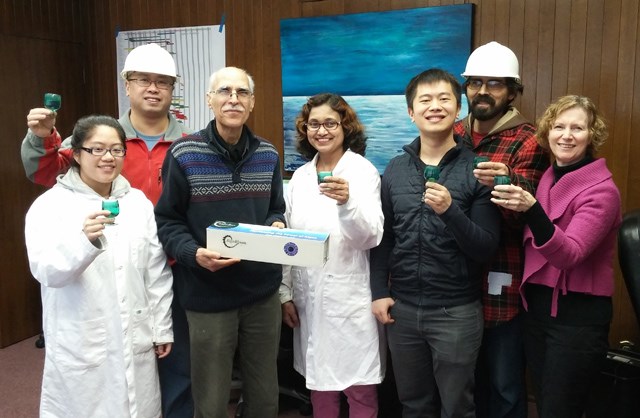Something that has been around for an estimated 3.5 billion years shows great persistence.
Now, a Richmond biotech firm is trying to match that resilience through its efforts to make blue green algae an everyday part of society’s diet.
Algabloom International is the creation of Soheyl and Susan Mottahedeh, who set up shop about a year ago to start growing the spirulina species which is often called a “super food” for its claims to provide health benefits that far outstrip other foods rich in minerals, protein and antioxidant properties.
Working from their River Road premises, where they employ 10 people, their 3,300-square-foot operation’s capacity can grow about 28 kilos of algae a day.
“We’re algae farmers,” said Soheyl proudly.
Their efforts to date have earned Algabloom International a nomination in the 13th Annual Small Business BC Awards in the categories of best employer and best workplace. The awards are handed out on Feb. 25 at the Pan Pacific Hotel in Vancouver.
While blue green algae as a food source has been marketed for some time, what sets apart Algabloom’s process — which has taken seven years to perfect — is the limited amount of water it takes to grow algae. While the technology to accomplish this is a closely guarded secret, Soheyl, an engineer and inventor, said the end product is more of a paste than something that floats on the top of a pond.
“Usually, other technologies require huge amounts of water,” he said. “We have been able to to develop a system that uses a very small amount. Therefore, we’ve been able to develop it to the point where the final algae is a dense paste.
“Other operations have to spend a lot of time and money extracting and separating algae from the water,” he said. “We don’t need to.”
“What also sets us apart is that we are actually producing fresh algae,” Susan said. “Virtually any health food store you go to today you can get dried spirulina, or capsule form. But we are harvesting and selling it fresh and frozen which is even more potent. Some of its effectiveness can be degraded in the drying process. And what we’re finding as we market this to juice companies and health clinics, they are excited to have a local, fresh product.”
According to the Mottahedehs, the algae, which has little taste in its fresh and frozen forms, has a long list of properties that can be beneficial for health. Since it is classed as a supplement, they are prohibited from making any overt claims.
But, they say it is packed with protein, has 31 times more beta carrotine than carrots, 51 times more iron than spinach, plus it possesses some anti-viral properties.
“It has 40 vitamins and 2,000 enzymes. It re-establishes and re-sets the cells of the human body,” Soheyl said. “It’s like re-booting your body. That’s what gives you that boost effect — more energy.”
“We see food as medicine,” Susan added. “And sometimes people get so tired of taking pills and this is a high potency food with an exceptional nutritional profile.”
To see an appreciable difference, depending on your state of health, the spirulina needs to be consumed for a few weeks. It can be easily blended into drinks or even taken straight.
Cost for a daily dose of spirulina — about two to three spoonfuls — is pegged at between $2 - $3 a day.
But in addition to its health properties, algae is being viewed as a product for the future that could help clean up the environment, be an important food source in a society with shrinking farmland, and even be a “green” fuel source.
“What is extraordinary with algae in general, and particularly the one we work with, is that every four hours it doubles itself,” Soheyl said. “Other plants can take three to four months to produce a crop. We harvest every day.”
All that’s needed is a constant environment of 33 degrees Celsius, plenty of light and a source of nutrients to grow.
“We have created those conditions here using aquaponics and the algae can grow quite fast,” Susan said.
“We see that algae has tremendous properties to help our planet,” Soheyl said. “It needs carbon dioxide to grow, so it gets rid of what we don’t want and gives us what we do want.”
In terms of a fuel source, large amounts can be dried and burned to generate electricity. And it can even have the potential to be used as a biofuel instead of crops grown to produce ethanol.
“It can be the antidote for all the pollution on the planet,” Soheyl said.



